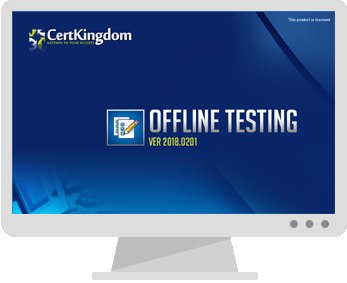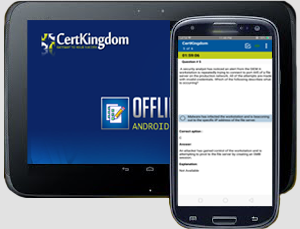Exam: JN0-363

|
|||||||||||||||||||||||||||
Thank you for your positive feedback about Certkingdom.com. We are happy to hear that our study materials and dedicated specialists have helped you prepare effectively for your certification exams and achieve success.
The Service Provider Routing and Switching track enables you to
demonstrate a thorough understanding of networking technology in general and
Juniper Networks service provider routing and switching platforms. JNCIS-SP, the
specialist-level certification in this track, is designed for networking
professionals with beginner to intermediate knowledge of routing and switching
implementations in Junos. The written exam verifies your basic understanding of
routing and switching technologies and related platform configuration and
troubleshooting skills.
This track contains four certifications:
JNCIA-Junos: Junos, Associate. For details, see JNCIA-Junos.
JNCIS-SP: Service Provider Routing and Switching, Specialist. For details, see
the sections below.
JNCIP-SP: Service Provider Routing and Switching, Professional. For details, see
JNCIP-SP.
JNCIE-SP: Service Provider Routing and Switching, Expert. For details, see JNCIE-SP.
Exam Details
Exam questions are derived from the recommended training and the exam
resources listed above. Pass/fail status is available immediately after taking
the exam. The exam is only provided in English.
Exam Code : JN0-363
Prerequisite Certification : JNCIA-Junos
Exam Length : 90 minutes
Exam Type : 65 multiple-choice questions
Software Versions : Junos OS 21.2
Exam Preparation
We recommend the following resources to help you prepare for your exam.
However, these resources aren't required, and using them doesn't guarantee
you'll pass the exam.
Recommended Training
Junos Intermediate Routing (JIR)
Junos Service Provider Switching (JSPX)
Junos MPLS Fundamentals (JMF)
Exam Resources
Industry/product knowledge
Juniper TechLibrary
Additional Preparation
Juniper Learning Portal
Exam Objectives
Here’s a high-level view of the skillset required to successfully complete
the JNCIS-SP certification exam.
Exam Objective / Description
Protocol-Independent Routing
Identify the concepts, operation, or functionality of various
protocol-independent routing components:
Static, aggregate, and generated routes
Martian addresses
Routing instances, including routing information base (RIB) (also known as
routing table) group
Load balancing
Filter-based forwarding
Demonstrate knowledge of how to configure, monitor, or troubleshoot various
protocol-independent routing components:
Static, aggregate, and generated routes
Load balancing
Filter-based forwarding
Open Shortest Path First (OSPF)
Identify the concepts, operation, or functionality of OSPF:
Link-state database
OSPF packet types
Router ID
Adjacencies and neighbors
Designated router and backup designated router
OSPF area and router types
Link-state advertisement (LSA) packet type
Demonstrate knowledge of how to configure, monitor, or troubleshoot OSPF:
Areas, interfaces and neighbors
Additional basic options
Routing policy application
Troubleshooting tools
Intermediate System to Intermediate System (IS-IS)
Identify the concepts, operation, or functionality of IS-IS:
Link-state database
IS-IS protocol data units (PDUs)
Type, length, values (TLVs)
Adjacencies and neighbors
Levels and areas
Designated intermediate system (DIS)
Metrics
Demonstrate knowledge of how to configure, monitor, or troubleshoot IS-IS:
Levels, interfaces and adjacencies
Additional basic options
Routing policy application
Troubleshooting tools
Border Gateway Protocol (BGP)
Identify the concepts, operation, or functionality of BGP:
BGP basic operation
BGP message types
Attributes
Route/path selection process
Internal and external BGP (IBGP and EBGP) functionality and interaction
Demonstrate knowledge of how to configure, monitor, or troubleshoot BGP:
Groups and peers
Additional basic options
Routing policy application
Layer 2 Bridging or VLANs
Identify the concepts, operation, or functionality of Layer 2 bridging for the
Junos OS:
Service provider switching platforms
Bridging elements and terminology
Frame processing
Virtual Switches
Provider bridging (Q-in-Q tunneling)
Identify the concepts, benefits, or functionality of VLANs:
Port modes
Tagging
Integrated Routing and Bridging (IRB)/li>
Demonstrate knowledge of how to configure, monitor, or troubleshoot Layer 2
bridging or VLANs:
Interfaces and ports
VLANs
IRB
Provider bridging
Spanning-Tree Protocols
Identify the concepts, benefits, operation, or functionality of Spanning Tree
Protocol and its variants:
Spanning Tree Protocol (STP), Rapid Spanning Tree Protocol (RSTP), Multiple
Spanning Tree Protocol (MSTP), and VLAN Spanning Tree Protocol (VSTP) concepts
Port roles and states
Bridge Protocol Data Units (BPDUs)
Convergence and reconvergence
Spanning-tree security
Demonstrate knowledge of how to configure, monitor, or troubleshoot STP and
its variants:
Spanning-tree protocols (STP, RSTP, MSTP, VSTP)
BPDU, loop and root protection
Multiprotocol Label Switching (MPLS)
Identify the concepts, operation, or functionality of MPLS:
MPLS terminology
MPLS packet header
End-to-end packet flow and forwarding
Labels and the label information base
MPLS and routing tables
RSVP
LDP
Segment routing
Demonstrate knowledge of how to configure, monitor, or troubleshoot MPLS:
MPLS forwarding
RSVP-signaled and LDP-signaled Label-Switched Paths (LSPs)
IPv6
Identify the concepts, operation, or functionality of IPv6:
IPv4 versus IPv6
Address types, notation, and format
Address scopes
Autoconfiguration
Tunneling
Demonstrate knowledge of how to configure, monitor, or troubleshooting IPv6:
Interfaces
Static routes
Dynamic routing (OSPFv3, IS-IS, BGP)
IPv6 over IPv4 tunneling
Tunnels
Identify the concepts, requirements, or functionality of IP tunneling:
Tunneling applications and considerations
Generic routing encapsulation (GRE)
Demonstrate knowledge of how to configure, monitor, or troubleshoot IP
tunnels:
GRE
High Availability
Identify the concepts, benefits, applications, or requirements of high
availability:
Link aggregation groups (LAGs) and multichassis LAGs (MC- LAGs)
Graceful restart (GR)
Graceful Routing Engine switchover (GRES)
Nonstop bridging (NSB)
Nonstop active routing (NSR)
Bidirectional Forwarding Detection (BFD)
Virtual Router Redundancy Protocol (VRRP)
Unified In-Service Software Upgrade (ISSU)
Demonstrate knowledge of how to configure, monitor, or troubleshoot high
availability components:
LAG
Graceful restart, GRES, NSB, and NSR
Virtual Router Redundancy Protocol (VRRP)
JN0-363 Brain Dumps Exam + Online / Offline and Android Testing Engine & 4500+ other exams included
$50 - $25 (you save $25)
Buy Now
QUESTION 1
Exhibit button
Which two statements are correct about the service provider MPLS network shown
in the exhibit?
(Choose two.)
A. R3 will perform a label pop operation on the transport MPLS label.
B. Traffic from Network 1 to Network 3 and traffic from Network 1 to Network 4
each need their own unique label-switched path.
C. Traffic from Network 1 to Network 3 and from Network 1 to Network 4 can share
the same labelswitched path.
D. R3 will perform a label swap operation on the transport MPLS label.
Answer: AD
QUESTION 2
Which two statements are correct about IS-IS? (Choose two.)
A. A level 1 only router can never form an adjacency with a level 2 only router.
B. For level 2 adjacencies, the area IDs can be different.
C. For level 2 adjacencies, the area IDs must be the same.
D. A level 1 only router can form an adjacency with a level 2 only router.
Answer: CD
QUESTION 3
You are adding an IPv6 configuration to an Interface on a Junos device.
In this scenario, which statement is correct?
A. The link local address must be manually configured within the fdO0:: prefix
range.
B. The link local address must be manually configured within the fe80:: prefix
range.
C. The link local address is automatically created using the MAC address within
the fe80::'l0 prefix range.
D. The link local address is automatically created using the MAC address within
the fd00:: prefix range.
Answer: D
QUESTION 4
Which statement is correct about IS-IS?
A. IS-IS is a distance vector routing protocol.
B. IS-IS is a path vector routing protocol.
C. IS-IS is a link-state routing protocol.
D. IS-IS is a classful routing protocol.
Answer: C
QUESTION 5
Which new field is added to an IPv6 header as compared lo IPv4?
A. version
B. checksum
C. fragment offset
D. flow label
Answer: D
Buy Complete
These are real testimonials.
Jason found the certkingdom training to be enjoyable and helpful as they followed the skills outline from Juniper.
Jason found the CertKingdom course to be great, and it helped him clear the JN0-363 exam. He appreciated how the training videos followed the skills outline from Juniper and covered all major areas. The practice tests also helped build his understanding and logic.
Scott:
cleared my exam in one week Despite being recently updated, this course feels
out of date. For example, there are 31 minutes of videos on QnA Maker, but this
service does not appear on the current study guide and it's not clear from the
course content how this differs from its replacement (Azure Cognitive Service
for Language). Furthermore, 10 minutes of videos on knowledge mining feels low
for an area that makes up 15-20% of the exam.
David Successfully cleared JN0-363 exam today with 960 marks. All the questions similar and came from this Mock tests. Thanks a lot certkingdom.
Rating: 4.3 / 5.0
I studied and pass my exams using cerkingdom material carefully and took
every question seriously. At last, I passed the exam with high score. Prepare
well and study much more.
It's great to hear that our study materials and practice tests helped our customers like Jason, Richel, David, and Hillary successfully pass their JN0-363 exams. It's always rewarding to hear about their success and we're glad that we could play a part in helping them reach their goals.
Certkingdom Offline Testing Engine Simulator Download
Prepare with yourself how CertKingdom Offline Exam Simulator it is designed specifically for any exam preparation. It allows you to create, edit, and take practice tests in an environment very similar to an actual exam.
Supported Platforms: Windows-7 64bit or later - EULA | How to Install?
FAQ's: Windows-8 / Windows 10 if you face any issue kinldy uninstall and reinstall the Simulator again.
Download Offline Simulator-Beta
Certkingdom Testing Engine Features
- Certkingdom Testing Engine simulates the real exam environment.
- Interactive Testing Engine Included
- Live Web App Testing Engine
- Offline Downloadable Desktop App Testing Engine
- Testing Engine App for Android
- Testing Engine App for iPhone
- Testing Engine App for iPad
- Working with the Certkingdom Testing Engine is just like taking the real tests, except we also give you the correct answers.
- More importantly, we also give you detailed explanations to ensure you fully understand how and why the answers are correct.
Certkingdom Android Testing Engine Simulator Download
Take your learning mobile android device with all the features as desktop offline testing engine. All android devices are supported.
Supported Platforms: All Android OS EULA
Install the Android Testing Engine from google play store and download the app.ck from certkingdom website android testing engine download

Certkingdom Android Testing Engine Features
- CertKingdom Offline Android Testing Engine
- Make sure to enable Root check in Playstore
- Live Realistic practice tests
- Live Virtual test environment
- Live Practice test environment
- Mark unanswered Q&A
- Free Updates
- Save your tests results
- Re-examine the unanswered Q & A
- Make your own test scenario (settings)
- Just like the real tests: multiple choice questions
- Updated regularly, always current




